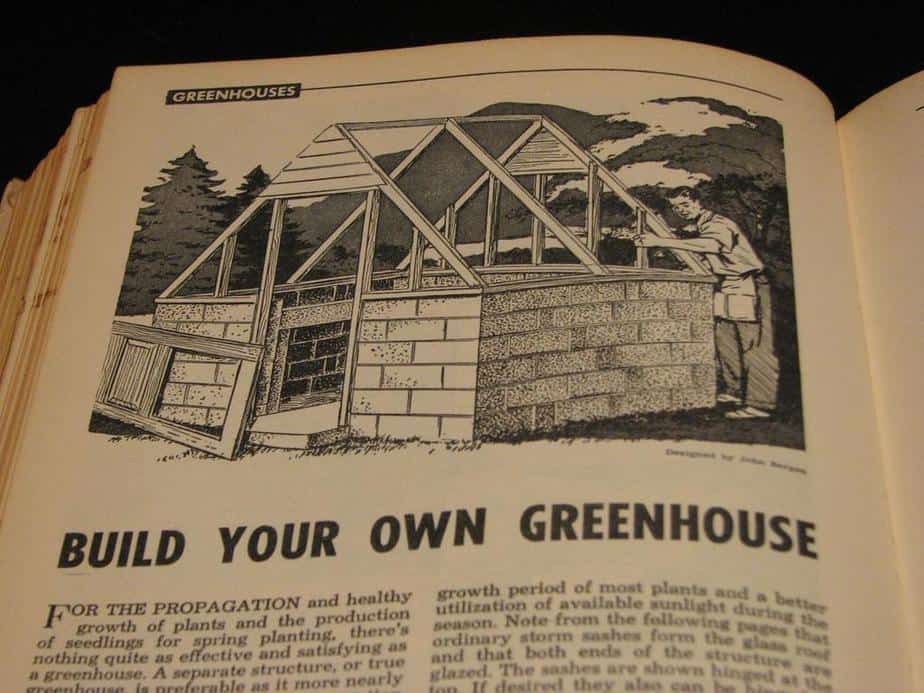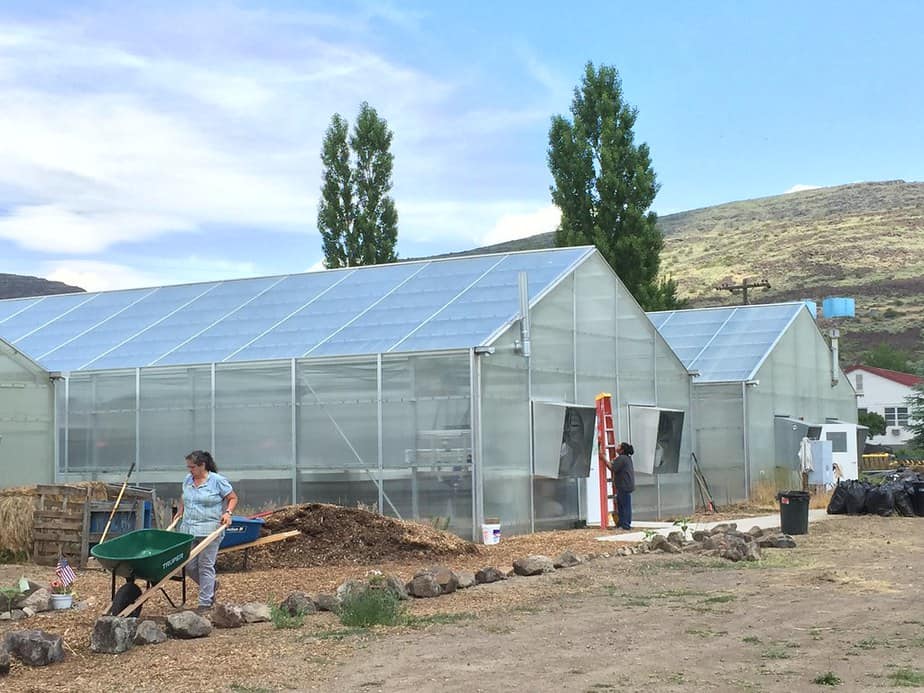Is a DIY greenhouse a reasonable fiscal option? Wouldn’t you like to know.

GO TO IMAGE’S WEBSITE
Fortunately, we’re going to go over all the associated costs as well as talk about mitigating them. So, it’s in your interest to stick around.
How Much Does A DIY Greenhouse Cost?
Are you planning a total DIY project? Or, can parts of your plant’s palace be purchased pre-fab? Which type of greenhouse are you going to construct?
Buy vs. Build

GO TO IMAGE’S WEBSITE
The cost of building your own greenhouse can vary greatly, depending on:
- Your location (Think: permits, zoning costs.)
- Greenhouse location (Is it free-standing or attached to another structure like your home?)
- Building materials
- Type of greenhouse
- Size of greenhouse
- Accessories and hook-ups needed (Electrical system, heaters and cooling, etc.)
Generally, you should estimate that building your own greenhouse will average at least $35 per square foot for the simplest kind, up to $90 per square foot for more sophisticated structure. Keep in mind that this is a very rough, subjective estimate.
The square foot cost varies most depending on type of house.
- A small, simple hoop house made with PVC pipe and plastic sheeting could cost under $5,000 to build and set up.
- A full-sized (averaging 12 foot by 12 foot) greenhouse with polycarbonate panels, an efficient heating-cooling and ventilation system, with electricity and all the accessories, can easily cost $30,000.
Now, when I say “build your own greenhouse,” I mean from scratch. Meaning: sourcing all your own materials, creating or finding a design plan, buying all necessary hardware, and so on and so on. Not only does this take quite a bit of time and planning, it obviously requires some skills that you may or may not have (no offense).
So. Many. Costs.
Don’t make the mistake of thinking that the materials for your greenhouse building—foundation, frame, and panels/covering—are the only major costs.
While these items can certainly add up, a huge chunk of building and maintaining a greenhouse comes along with the little things. Think of these necessary (and often year-after-year) additions when planning your greenhouse:
- Electrical system
- Irrigation system
- Heating and cooling systems
- Thermostat
- Fans
- Lights
- Utility bills (maybe try solar?)
- Benches and shelving
- Soil, containers, garden tools
- And of course—plants!
To get a fuller picture of the costs involved in operating a greenhouse, read through our Hidden Costs of A Greenhouse guide.
Buying A Greenhouse Kit

GO TO IMAGE’S WEBSITE
Want to go simpler? Buy a greenhouse kit. You’ll pay more but save time and effort. You’ll simply need tools and ability to follow (somewhat complicated) building directions.
You can, amazingly, find a small greenhouse kit for under $500. Larger houses with more growing (and walking/standing-up space) can dig a $4,000–$5,000 hole in your pocket.
Remember, that’s just for the house materials.
Willing to spend more cash to save more time and effort? Hire a professional to put together the greenhouse kit for you! Many garden and home improvement stores, and even online retailers, offer this add-on service with purchase.
Pro tip: a good, functional greenhouse doesn’t have to be enormous or complex. Depending on what you desire from your greenhouse, you can do a lot with a little bit of space.
How To Build A Simple, Inexpensive Greenhouse

GO TO IMAGE’S WEBSITE
Some more tips on keeping your greenhouse building costs down:
- Use recycled/upcycled materials like windows, doors, and even old floor lumber.
- Use old or recycled tempered or safety glass windows, if possible.
- Build a foundation out of old windows, upcycled bricks, or even snap-together floor tiles.
- Be sure to use a lightweight, waterproof material for the roof, or you’ll be replacing it every season.
A Simple PVC Pipe House
A small greenhouse made of PVC pipe and plastic sheeting is the most economical, quick-and-easy way to start all-weather growing in your garden.
- Cut PVC pipes to the size you need. You’ll need a pipe-cutting tool.
- Connect with PVC glue or cement in the desired shape.
- You can also use bolts or screws to connect the pipes (after drilling holes at junctions), or even zip-tie them together.
- Use PVC fittings like elbows, Ts or Ys to create the structure you want.
- Cover with plastic sheeting, tucking in at the edges to seal off any gaps. Be sure to tuck it in around the bottom of the pipe structure or into the foundation or your greenhouse to seal it completely
Ready, set, grow!
Do You Need A Foundation?
The building site for your greenhouse needs to be level. So while not all greenhouses need a foundation, you may need one.
Pick a flat, stable piece of land on which to construct your greenhouse to save the hassle and cost of putting in a foundation.
Best Materials to Build A Greenhouse

GO TO IMAGE’S WEBSITE
Frame Material
The most common materials for a greenhouse frame are wood, PVC pipes, aluminum, and steel.
They all have their pros and cons, including cost, durability, and ease of use.
- Wood: lovely to look at, but can swell, get damp, and rot. Use a moisture-resistant timber like cedar.
- PVC pipes: cheap, lightweight, easy to build with. Great to use with polyethylene sheeting. Only somewhat durable, but can be made more hearty by choosing UV-protected PVC.
- Aluminum: won’t rust, is very durable, and works well with polycarbonate. Highly recommended!
- Galvanized steel: will rust, so it’s typically only used with polyethylene sheeting. Not recommended unless you really know what you’re doing!
Glazing / Covering Material
While glass is the traditional material for greenhouses, it’s now become quite outdated. Glass is heavy, fragile, and expensive. Most greenhouses (i.e., not those classic conservatories you might visit on vacation) use polycarbonate, acrylic, fiberglass, or polyethylene sheeting.
Check out our full guide to greenhouse coverings for an in-depth look at each material.
- Glass: expensive and fickle. But pretty!
- Polyethylene: We’re also calling this “plastic sheeting” elsewhere in this article, but this is its fancy name. Extremely cheap and easy to work with, but the least durable and insulating option. Usually needs to be replaced annually.
- Polycarbonate: More expensive, durable. Insulates very well.
Is Building A Greenhouse Worth It?

GO TO IMAGE’S WEBSITE
Is Owning A Greenhouse Profitable?
If you eat a lot of tomatoes, building a greenhouse is worth it.
I know, this sounds a bit extreme. But think about it. Tomatoes can get expensive—especially when they’re out of season. Which, for most of the United States, is a lot of the year.
That means you’re relying on imported (and, most likely, dry and flavorless) tomatoes from the grocery store.
In this gardener’s opinion, that brings to light one of the best things about investing in a backyard greenhouse: eliminating mediocre-tasting veggies from other countries, flown to you across oceans, possibly grown and harvested by people who don’t have fair or safe working conditions.
Even if you measure profit in only dollars, your greenhouse will eventually pay for itself. But open your mind to the possibilities of saving carbon emissions, trips to the grocery store, support of unjust labor practices for farmworkers, and dependence on a commercialized ag system? Plus: gaining fun, expertise, and self-sufficiency?
Worth it.
But looking back at dollars: it may take a few seasons to feel like you are producing enough food and flora to justify the many-thousands-of-dollars cost of building your greenhouse. Take heart. If you maintain the house well and care for your plants, you will be saving money in the long run.
Can A Greenhouse Be Used Year-Round?
Heck yes, it can!
But that will take a little extra effort on your part. Plus some money, appliances, and a lot of attention.
You likely live in a climate that gets cold enough during the Fall and Winter months that you can’t garden outside. Hence, your desire for a greenhouse!
An all-season greenhouse will need an efficient heating and cooling system. All greenhouses need a good ventilation system, but it’s even more important in variable climates.
Pros and Cons of A Greenhouse
Another very subjective question, weighing the pros and cons of having a backyard greenhouse will greatly depend on your lifestyle and expectations.
Do you find joy in growing your own food?
Do you love building and tinkering? Or do you get frustrated by tasks like repairing and installing appliances?
Are you in it for the long haul? Or do you tend to lose interest in projects after they become “un-shiny”?
How invested are you in becoming more self-sufficient, especially when it comes to the food you eat?
All of these questions will help guide to your own personal pro-con list. For the full scope of what’s good and bad about a backyard greenhouse, read: Is A Greenhouse Worth the Cost?
Just like any other home improvement project, building and maintaining a greenhouse is an investment and a commitment. Take a good look at costs, time and effort, your lifestyle, and your home climate before you decide to construct a great glass house full of exotic plants in your urban backyard.




